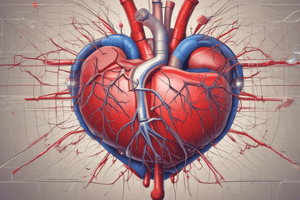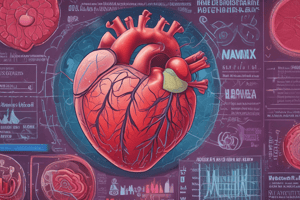Podcast
Questions and Answers
What is the primary function of cardiac biomarkers?
What is the primary function of cardiac biomarkers?
- To detect congestive heart failure
- To detect acute myocardial infarction or minor myocardial injury (correct)
- To monitor high blood pressure
- To diagnose coronary heart disease
What is the main reason for the evolution of criteria for the definition of myocardial infarction?
What is the main reason for the evolution of criteria for the definition of myocardial infarction?
- Changes in symptoms of ischemia
- Increased awareness about cardiovascular disease
- Advancements in electrocardiogram technology
- Improvement in detection technologies, particularly biomarkers (correct)
What is the term for diseases that affect the circulatory system?
What is the term for diseases that affect the circulatory system?
- Peripheral vascular disease
- Coronary heart disease
- Cerebrovascular disease
- Cardiovascular disease (correct)
What is NOT a type of cardiovascular disease?
What is NOT a type of cardiovascular disease?
According to the American College of Cardiology and European Society of Cardiology, what is the recommended biomarker for diagnosing acute myocardial infarction?
According to the American College of Cardiology and European Society of Cardiology, what is the recommended biomarker for diagnosing acute myocardial infarction?
What is the old criteria for diagnosing acute myocardial infarction, according to the World Health Organization (1979)?
What is the old criteria for diagnosing acute myocardial infarction, according to the World Health Organization (1979)?
What is the term for heart and blood vessel diseases?
What is the term for heart and blood vessel diseases?
What is NOT a type of cardiovascular disease mentioned in the content?
What is NOT a type of cardiovascular disease mentioned in the content?
What is the main characteristic of the fourth group of patients who present to the emergency department?
What is the main characteristic of the fourth group of patients who present to the emergency department?
What is the ideal characteristic of a biomarker for detecting AMI?
What is the ideal characteristic of a biomarker for detecting AMI?
What is the main difference between various biomarkers of myocardial injury?
What is the main difference between various biomarkers of myocardial injury?
What is the function of the troponin complex in muscular contraction?
What is the function of the troponin complex in muscular contraction?
Why is troponin C not a suitable cardiac-specific marker?
Why is troponin C not a suitable cardiac-specific marker?
What is unique about troponin T and I?
What is unique about troponin T and I?
What is the significance of the cardiac-specific forms of troponin T and I?
What is the significance of the cardiac-specific forms of troponin T and I?
What is a characteristic of an ideal biomarker for detecting AMI?
What is a characteristic of an ideal biomarker for detecting AMI?
What is the molecular weight of Troponin T?
What is the molecular weight of Troponin T?
What is the nature of the protein of Troponin I?
What is the nature of the protein of Troponin I?
What is the duration of elevation of Troponin T?
What is the duration of elevation of Troponin T?
What is the likelihood of ischemic complications in patients with unstable angina who have normal CK-MB and increased TnI?
What is the likelihood of ischemic complications in patients with unstable angina who have normal CK-MB and increased TnI?
What does an increase in plasma troponin concentration indicate?
What does an increase in plasma troponin concentration indicate?
When does Troponin I appear in the blood after myocardial damage?
When does Troponin I appear in the blood after myocardial damage?
What is the cutoff for acute myocardial infarction on a Beckman Coulter DXi analyzer?
What is the cutoff for acute myocardial infarction on a Beckman Coulter DXi analyzer?
What is the pattern of release of Troponin I in Myocardial Infarction (MI)?
What is the pattern of release of Troponin I in Myocardial Infarction (MI)?
What does a normal TnI and elevated CK-MB usually indicate?
What does a normal TnI and elevated CK-MB usually indicate?
Why is Troponin I beneficial in detecting infarctions in late presenting patients?
Why is Troponin I beneficial in detecting infarctions in late presenting patients?
What is a common non-ischemic cause of elevated plasma TnI concentration?
What is a common non-ischemic cause of elevated plasma TnI concentration?
What percentage of patients with unstable angina have elevated Troponin I?
What percentage of patients with unstable angina have elevated Troponin I?
Why is Troponin I a better risk indicator in angina than CK-MB?
Why is Troponin I a better risk indicator in angina than CK-MB?
What does two normal TnI levels indicate in a patient with unstable angina?
What does two normal TnI levels indicate in a patient with unstable angina?
What is a likely diagnosis for a patient with elevated TnI and normal CK-MB?
What is a likely diagnosis for a patient with elevated TnI and normal CK-MB?
Based on the case study, has the 66-year-old man suffered a myocardial infarction?
Based on the case study, has the 66-year-old man suffered a myocardial infarction?
What does the patient's 2-year history of angina of effort suggest?
What does the patient's 2-year history of angina of effort suggest?
Based on the elevated CK and CK-MB levels, what is the most likely diagnosis for the marathon runner?
Based on the elevated CK and CK-MB levels, what is the most likely diagnosis for the marathon runner?
What is the primary concern for the 52-year-old man with severe chest pain?
What is the primary concern for the 52-year-old man with severe chest pain?
What is the significance of the CK-MB percentage in the marathon runner's laboratory results?
What is the significance of the CK-MB percentage in the marathon runner's laboratory results?
What is the relevance of the patient's attendance at the chest pain clinic to the current diagnosis?
What is the relevance of the patient's attendance at the chest pain clinic to the current diagnosis?
What is the purpose of requesting specific tests from the biochemistry laboratory for the 52-year-old man?
What is the purpose of requesting specific tests from the biochemistry laboratory for the 52-year-old man?
Flashcards are hidden until you start studying
Study Notes
Cardiovascular Disease (CVD)
- CVD includes heart and blood vessel diseases that affect the circulatory system.
- Examples of CVD include:
- Coronary heart disease (heart attack)
- Cerebrovascular disease (stroke)
- High blood pressure
- Congestive heart failure
- Congenital cardiovascular defects
- Peripheral vascular disease
Cardiac Biomarkers
- A cardiac biomarker is a clinical laboratory test used to detect acute myocardial infarction (AMI) or minor myocardial injury.
- Cardiac biomarkers are most useful when patients have nondiagnostic ECG tracings.
Evolving Definitions of Myocardial Infarction (MI)
- The criteria for the definition of MI have evolved over the years, partly due to improvements in detection technologies, including biomarkers.
- The old diagnosis of AMI was based on 2 out of 3 of WHO criteria (1979), including:
- Symptoms of ischemia (prolonged chest pain)
- ECG changes
- Cardiac biomarker concentrations (enzymes)
- The new definition of AMI is based on documenting an increase in cardiac troponin or CK-MB mass in the context of myocardial ischemia.
Ideal Marker to Detect AMI
- An ideal marker should have:
- High concentration in myocardium
- Absence from non-myocardial tissues
- High sensitivity and specificity in circulation
- Rapid release into blood following myocardial injury
- Remain in blood for several days to allow detection
- Blood levels correlate with extent of myocardial injury and prognosis
- Rapid, simple, and automated commercial assays available
Troponins
- Troponins are regulatory proteins in striated muscle responsible for calcium-modulated interaction.
- There are cardiac-specific forms of troponin, including:
- Troponin T (TpnT)
- Troponin I (TpnI)
- Troponins T and I have different characteristics, including:
- Molecular weight (37 kDa vs 22.5 kDa)
- Nature of protein (structural vs catalytic)
- Kinetics of release (biphasic vs single peak)
- Duration of elevation (up to 14 days vs 5-7 days)
Troponin Release Kinetics
- Troponin release is biphasic, with:
- Detectable in blood 3-12 hours after MI
- Peak levels at 12-38 hours
- Remain elevated for 5-10 days
- TnI remains elevated longer than CK-MB due to ongoing release of the myofibril-bound fraction.
Clinical Applications of Troponins
- Elevated TnI is found in 30-40% of patients with unstable angina and is a better risk indicator than CK-MB.
- Serial monitoring of TnI over 8-12 hours is becoming common practice in many well-developed institutions.
- To rule out an acute myocardial infarction, many centers are ordering CK-MB and TnI on admission and again at either 8 or 12 hours.
- An increase in plasma troponin concentration is indicative of myocardial injury, but not synonymous with MI.
Non-Ischemic Causes of Elevated Troponin
- Congestive heart failure
- Hypertension
- Circulatory shock
- Pulmonary embolism
- Covid-19
- Mechanical injury
- Cardiac contusion
- Cardiotrophic viral infections
- Chemotherapy
- Renal failure
- GI bleed
Studying That Suits You
Use AI to generate personalized quizzes and flashcards to suit your learning preferences.





